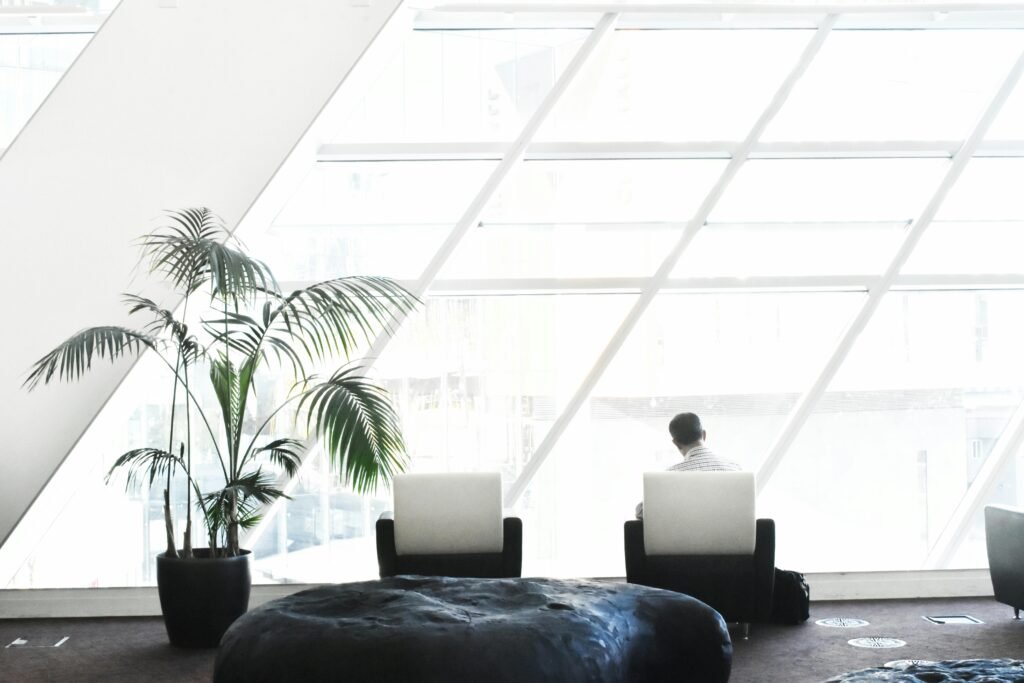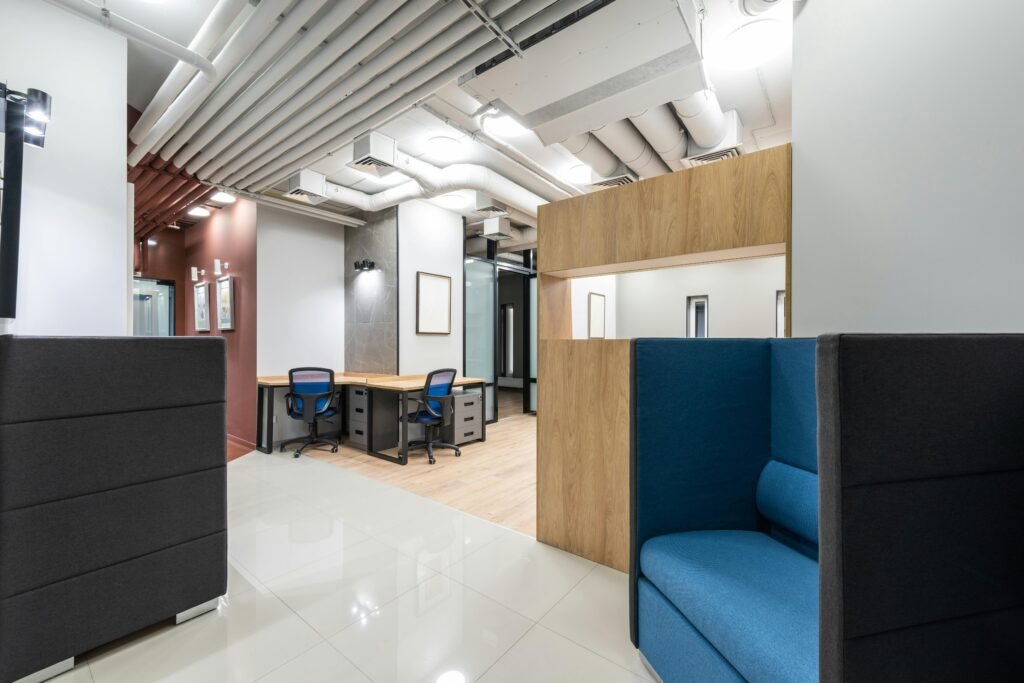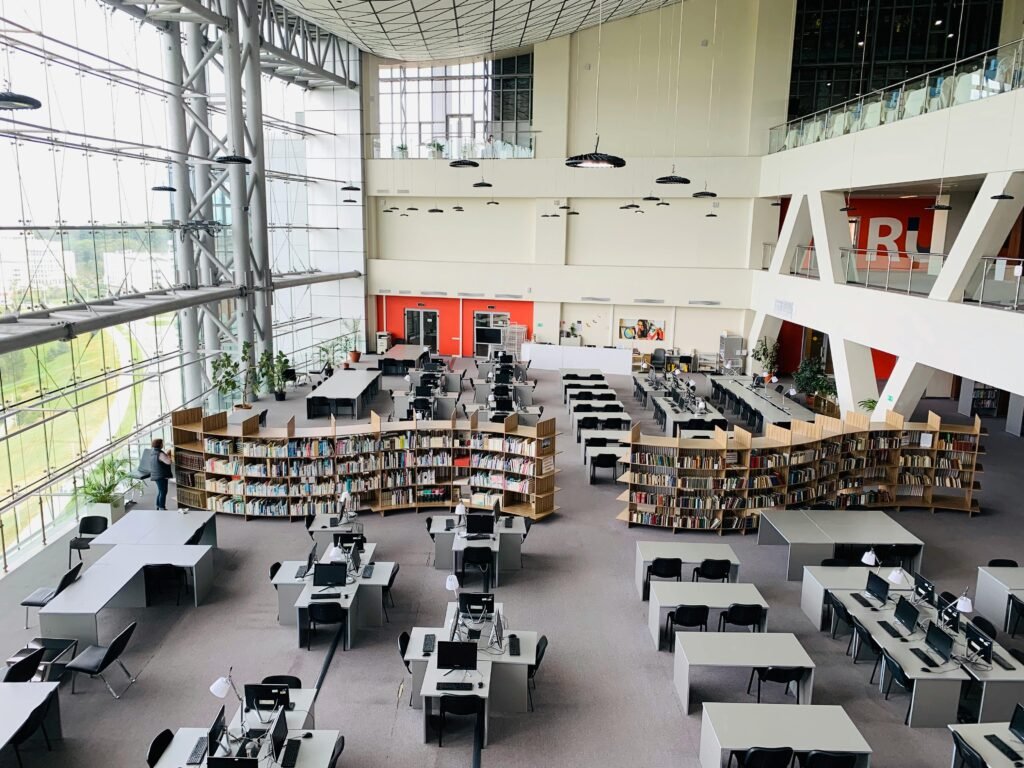
Table of Contents
ToggleIntroduction
Creating a well-organized office is essential for mental well-being and productivity at work. Whether you work at home or in the office, a peaceful space can help reduce stress and increase focus. Today’s blog covers everything you need to do to create a beautiful workplace. So let’s find out-
Use soothing colors
Soft Blues: Consider painting the walls or incorporating soft blue accents throughout the office. Blue is known for its calming and serene qualities, making it an ideal choice for promoting relaxation and reducing stress levels. Soft shades of blue evoke a sense of tranquility, helping employees stay centered and focused on their tasks.

Neutral Tones:
Embrace neutral tones such as beige, taupe, and gray to create a balanced and inviting atmosphere in the office. Neutral colors provide a versatile backdrop that complements various design elements and promotes a sense of harmony and stability. These understated hues can help reduce visual clutter and create a clean and organized workspace.
Pastel Greens:
Infuse the office with pastel green hues to evoke feelings of balance, renewal, and vitality. Green is associated with nature and growth, making it a refreshing and energizing color choice for the workspace. Pastel greens can instill a sense of optimism and optimism, fostering a positive and uplifting work environment.
Soft Lavenders:
Incorporate soft lavender tones to add a touch of elegance and sophistication to the office. Lavender is often associated with relaxation and tranquility, making it an excellent choice for promoting a calm and peaceful atmosphere. Soft lavender accents can help reduce tension and create a sense of serenity in the workplace.

Warm Neutrals:
Explore warm neutral tones such as sand, camel, and ivory to infuse the office with a sense of warmth and comfort. Warm colors create a cozy and inviting environment that encourages collaboration and communication among employees. These earthy hues can help foster a sense of community and camaraderie in the workplace.
Muted Yellows:
Incorporate muted yellow tones to add warmth and optimism to the office environment. Yellow is associated with happiness and positivity, making it an uplifting and energizing color choice. Muted yellow accents can help boost morale and motivation, encouraging employees to approach their work with enthusiasm and confidence.
By incorporating soothing colors into the office design, employers can create a conducive environment that promotes productivity, creativity, and overall well-being. Whether through wall paint, furniture, or decor accents, the strategic use of calming hues can transform the workspace into a sanctuary where employees can thrive and flourish. Embrace the power of color psychology to enhance the office experience and unlock the full potential of your team.
Natural Ingredients

Essential Oils: Harness the power of aromatherapy by diffusing essential oils throughout the office. Scents like lavender, peppermint, and citrus can uplift mood, reduce stress, and improve concentration. Consider using a diffuser or simply add a few drops of essential oil to a bowl of water for a subtle fragrance.
Indoor Plants: Introduce greenery into the office environment with indoor plants known for their air-purifying properties. Plants such as snake plants, pothos, and peace lilies not only add aesthetic appeal but also help remove toxins from the air, resulting in cleaner and fresher indoor air quality.
Natural Light: Maximize natural light exposure by positioning desks and workstations near windows or skylights. Natural light not only reduces reliance on artificial lighting but also boosts mood, regulates circadian rhythms, and enhances productivity. Consider installing sheer curtains or blinds to control glare and maximize daylight penetration.
Bamboo Furniture: Opt for sustainable and eco-friendly furniture options such as bamboo desks, chairs, and shelving units. Bamboo is a renewable resource known for its durability, strength, and natural beauty. Incorporating bamboo furniture into the office adds a touch of elegance while minimizing environmental impact.
Beeswax Candles: Create a cozy and inviting ambiance with beeswax candles placed strategically around the office. Unlike paraffin candles, beeswax candles emit negative ions that help neutralize pollutants in the air, promoting cleaner indoor air quality. Choose candles scented with natural essential oils for added aromatherapy benefits.
Himalayan Salt Lamps: Enhance the atmosphere and promote relaxation with Himalayan salt lamps placed in key areas of the office. These lamps emit a soft, warm glow and release negative ions into the air, which can counteract the positive ions generated by electronic devices. Himalayan salt lamps are not only aesthetically pleasing but also contribute to a calmer and more balanced environment.
Natural Cleaning Products: Switch to natural and eco-friendly cleaning products to maintain a healthier office environment. Traditional cleaning products often contain harsh chemicals that can irritate the respiratory system and trigger allergies. Opt for plant-based cleaners that are free from synthetic fragrances, dyes, and toxins, ensuring a safer and more sustainable cleaning routine.
Organic Snacks and Beverages: Stock the office kitchen with organic snacks and beverages made from wholesome, natural ingredients. Provide options such as fresh fruits, nuts, herbal teas, and organic granola bars to fuel productivity and support overall well-being. Choosing organic options reduces exposure to pesticides and promotes healthier eating habits among employees.

By incorporating these natural ingredients into the office environment, employers can create a healthier, more sustainable workspace that fosters productivity, creativity, and employee satisfaction. Embrace the power of nature to transform your office into a vibrant and rejuvenating space where everyone can thrive.
Ergonomic and comfortable office furniture

Prioritizing employee comfort and well-being is paramount for fostering productivity, creativity, and overall satisfaction. Selecting ergonomic and comfortable office furniture plays a crucial role in creating a supportive and healthy work environment. Here are specific and up-to-date tips for choosing the right ergonomic office furniture:
Ergonomic Chairs: Invest in ergonomic chairs designed to provide proper support and promote good posture. Look for chairs with adjustable features such as seat height, lumbar support, armrests, and tilt mechanisms. Choose chairs with breathable materials and ample cushioning to ensure comfort during long hours of sitting.
Adjustable Desks: Consider adjustable desks that allow employees to alternate between sitting and standing throughout the workday. Sit-stand desks promote movement, reduce sedentary behavior, and alleviate pressure on the spine. Look for desks with smooth height-adjustment mechanisms and spacious work surfaces to accommodate various tasks and preferences.
Keyboard Trays and Monitor Arms: Incorporate keyboard trays and monitor arms to optimize workstation ergonomics and reduce strain on the wrists, arms, and neck. Adjustable keyboard trays allow for proper alignment of the wrists and forearms, while monitor arms enable easy adjustment of screen height and angle to minimize neck and eye strain.
Footrests and Footstools: Provide footrests or footstools to support proper leg and foot positioning while seated. Footrests help alleviate pressure on the lower back and promote circulation by allowing employees to maintain a comfortable and ergonomic sitting posture. Look for adjustable footrests that accommodate different heights and preferences.

Supportive Cushions and Pillows: Offer supportive cushions and pillows for additional comfort and lumbar support. Seat cushions and backrest pillows can help alleviate discomfort and pressure points, especially for employees with existing back or posture issues. Choose cushions made from high-quality foam or memory foam for optimal support and durability.
Standing Mats: Enhance the comfort of standing workstations with anti-fatigue standing mats. These ergonomic mats provide cushioning and support for the feet, legs, and joints, reducing fatigue and discomfort associated with prolonged standing. Look for mats with non-slip surfaces and beveled edges for safety and stability.
Collaborative Seating Options: Incorporate collaborative seating options such as lounge chairs, bean bags, or modular seating arrangements to promote flexibility and creativity in the workspace. These alternative seating solutions offer employees a comfortable and informal environment for brainstorming, meetings, or relaxation, fostering collaboration and innovation.
Minimize Office Noise Distractions

Noise distractions can hinder productivity and disrupt concentration. Implementing effective strategies to mitigate office noise is essential for creating a conducive work environment where employees can focus and perform their best. Here are five specific and up-to-date methods to avoid office noise:
Soundproofing Solutions: Invest in soundproofing materials such as acoustic panels, curtains, and wall coverings to absorb and reduce noise levels within the office. Place acoustic panels strategically in high-traffic areas or near sources of noise to minimize reverberation and echo.
White Noise Machines: Install white noise machines or sound masking systems to create a consistent background noise that masks disruptive sounds. White noise helps to drown out distractions and creates a more peaceful and focused work environment without being overly intrusive.
Headphones and Earplugs: Encourage employees to use headphones or earplugs to block out unwanted noise and maintain concentration. Provide noise-canceling headphones or earbuds for employees who require additional noise reduction, particularly in open office environments.
Noise-Canceling Office Furniture: Invest in noise-canceling office furniture such as acoustic desk dividers or privacy screens to create individual workspaces that reduce noise transmission. These innovative solutions help create a sense of privacy and focus in open office layouts without sacrificing collaboration.

Establish Noise Policies: Establish clear guidelines and policies regarding acceptable noise levels and behavior in the office. Encourage employees to be mindful of their volume when speaking, using electronic devices, or engaging in conversations. Educate employees about the impact of noise on productivity and the importance of maintaining a quiet work environment.
Optimizing Office Comfort

Maintaining an optimal temperature in the workplace is crucial for employee comfort, productivity, and overall well-being. Whether it’s battling the summer heat or combating the winter chill, achieving the perfect balance can be a challenge. Here are specific and up-to-date tips to master temperature control in the office
Invest in Programmable Thermostats: Upgrade to programmable thermostats to regulate indoor temperature efficiently. These advanced systems allow you to schedule temperature adjustments based on occupancy patterns and office hours. Set comfortable temperatures during working hours and adjust settings during off-peak times to conserve energy and reduce costs.
Utilize Zoning Systems: Implement zoning systems to customize temperature settings in different areas of the office based on occupancy and usage patterns. Divide the workspace into zones and install separate thermostats or temperature controls for each zone. This allows you to tailor heating and cooling levels to meet the specific needs of different departments or work areas.
Optimize Airflow with Fans: Use fans strategically to improve airflow and circulation in the office. Ceiling fans, oscillating fans, or desk fans can help distribute air evenly and alleviate hot spots or stagnant areas. Position fans near windows or doorways to facilitate natural ventilation and enhance comfort without relying solely on air conditioning.
Maximize Natural Ventilation: Take advantage of natural ventilation whenever possible to regulate indoor temperature and improve air quality. Open windows and doors during mild weather conditions to allow fresh air to circulate throughout the office. Install window screens or vents to prevent insects or debris from entering while promoting airflow.
Maintain HVAC Systems Regularly: Schedule routine maintenance and inspections for HVAC (Heating, Ventilation, and Air Conditioning) systems to ensure optimal performance and efficiency. Clean or replace air filters regularly to prevent dust buildup and maintain airflow. Address any issues or malfunctions promptly to avoid disruptions in temperature control.
Provide Personal Comfort Options: Offer employees the flexibility to personalize their workspace temperature with individual comfort options. Allow them to use personal heaters or fans to supplement central heating and cooling systems. Provide lightweight blankets or shawls for individuals who prefer extra warmth during cooler months.
Monitor Indoor Humidity Levels: Monitor indoor humidity levels to ensure optimal comfort and air quality in the office. High humidity can make the environment feel warmer and contribute to feelings of discomfort and stuffiness. Use dehumidifiers to remove excess moisture from the air during humid conditions and maintain humidity levels within the recommended range.

Seek Employee Feedback: Solicit feedback from employees regarding their temperature preferences and comfort levels in the office. Conduct surveys or informal discussions to gather input on temperature control effectiveness and identify areas for improvement. Consider implementing flexible temperature policies or adjustments based on employee feedback to enhance satisfaction and productivity.
Creative Office Wall Decoration Ideas and Accessories

Transforming your office walls into vibrant and inspiring spaces can significantly enhance the atmosphere and boost productivity. From eye-catching artwork to functional accessories, there are endless possibilities for creating a personalized and motivating environment. Here are specific and up-to-date ideas for office wall decoration and accessories:
Gallery Wall: Create a gallery wall by arranging a curated collection of artwork, photographs, and prints. Mix and match different sizes, styles, and frames to add visual interest and personality to the space. Incorporate motivational quotes or company values into the gallery display to reinforce your brand identity and inspire employees.
Acoustic Panels: Install acoustic panels on office walls to improve sound quality and reduce noise levels in open-plan workspaces. Choose panels with stylish designs or customizable options to enhance aesthetics while enhancing acoustic performance. Acoustic panels not
only create a quieter environment but also contribute to a more comfortable and focused atmosphere.

Whiteboards and Chalkboards: Incorporate whiteboards or chalkboards into office walls to facilitate brainstorming sessions, meetings, and creative collaboration. Use these writable surfaces for jotting down ideas, sketching diagrams, or creating to-do lists. Opt for magnetic whiteboards to display documents or notes with magnets for added versatility.
Floating Shelves: Install floating shelves on office walls to display books, plants, or decorative accessories while maximizing vertical space. Choose shelves in various sizes and finishes to complement the existing decor and provide additional storage solutions. Floating shelves add visual interest and functionality to bare walls, making them ideal for showcasing personal touches or organizational essentials.
Wall-mounted Organizers: Incorporate wall-mounted organizers such as file holders, magazine racks, or mail organizers to keep paperwork and office supplies tidy and accessible. Select organizers with sleek designs or customizable features to complement your workspace aesthetic and streamline organization. Wall-mounted organizers help free up desk space and promote a clutter-free environment.
Cork Boards or Pinboards: Hang cork boards or pinboards on office walls to display notes, memos, and reminders in a centralized location. Use pushpins or thumbtacks to attach documents, photos, or inspirational images to the board. Cork boards provide a practical and visually appealing way to keep important information visible and organized.
Wall Decals or Murals: Add personality and style to office walls with removable wall decals or murals featuring custom designs or graphics. Choose decals that reflect your company culture, values, or brand identity to create a cohesive and engaging environment. Wall decals are easy to apply and remove, making them ideal for temporary or seasonal decorations.
Plants and Greenery: Introduce plants and greenery into the office environment by hanging wall-mounted planters or installing living walls or vertical gardens. Incorporating plants into office walls not only enhances aesthetics but also improves air quality, reduces stress, and boosts productivity. Select low-maintenance plants that thrive indoors and require minimal care to maintain.
Digital Displays or Screens: Install digital displays or screens on office walls to showcase dynamic content, announcements, or presentations. Use digital signage software to schedule and manage content effectively, keeping employees informed and engaged. Digital displays add a modern and interactive element to office walls, providing opportunities for communication and visual storytelling.
Custom Artwork or Branding: Commission custom artwork or branding elements to personalize office walls and reinforce your company’s identity and culture. Work with local artists or graphic designers to create bespoke pieces that resonate with your brand values and resonate with employees. Custom artwork adds a unique and memorable touch to office walls, creating a welcoming and inspiring atmosphere.

Conclusion
Decorating the office is more than just adding aesthetic appeal; it’s about creating a functional and inspiring environment that enhances productivity, creativity, and well-being. By implementing thoughtful design elements and accessories, businesses can transform their workspace into a dynamic hub of innovation and collaboration.
From ergonomic furniture and soothing color schemes to strategic lighting and personalized decor, every detail contributes to the overall atmosphere and employee experience.
Moreover, incorporating elements of nature, such as indoor plants and natural materials, can bring a sense of calm and vitality to the office, while effective organization solutions help maintain tidiness and efficiency.
Embracing technology, such as digital displays and smart gadgets, further enhances functionality and connectivity in the modern workplace.
Furthermore, it’s essential to consider the specific needs and preferences of employees when decorating the office. Providing spaces for relaxation, collaboration, and focus ensures that everyone can work comfortably and effectively.
Additionally, promoting sustainability through eco-friendly design choices and energy-efficient practices contributes to a healthier planet and a more responsible business ethos.
Ultimately, the goal of decorating the office is to create a space that supports the success and well-being of both employees and the organization as a whole. By prioritizing comfort, functionality, and aesthetics, businesses can foster a positive and inspiring work environment that attracts talent, boosts morale, and drives innovation.
With careful planning and creativity, the office can become not only a place of work but also a source of inspiration and pride for everyone involved.
helpful ❤️